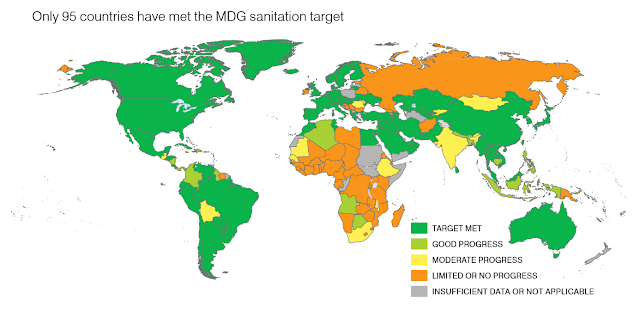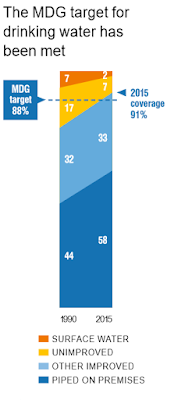 |
| The 2015 JMP update and MDG Assessment. Credit: UNICEF/WHO |
The Joint Monitoring Programme for Water Supply and Sanitation (JMP) run by the WHO and UNICEF was responsible for the monitoring of progress towards the Millennium Development Goals (MDG). Earlier this year they released the latest estimates on sanitation and drinking water at the end of the MDG era with reports on progress from 1990-2015. In my last blog I was relatively critical of metrics relating to access. Nonetheless, the report presents the latest findings on urban water and sanitation and therefore it makes sense to do a short short blog outline the key findings.
 |
| Figure 1: Use of improved drinking water sources and MDG target in 2015, and percentage point change from 1990 to 2015, Source: UNICEF/WHO |
Drinking Water
- 91% of the global population now uses an improved drinking source up from 76% in 1990 at the start of JMP. This figure is 96% for urban areas.
- The global target for the MDG was met in 2010, 5 years ahead of the deadline, with 2.6 billion people having gained 'access' to an improved source since 1990.
- However, in 2015 633 million people still lack access to improved drinking water sources and this figure may well be higher if you question what 'access' really means. As figure 1 shows, five developing regions met the drinking water target. Yet, of the five that didn't, two were within Africa: Northern Africa and sub-Saharan Africa.
Sanitation
- Improvements in sanitation were much lower than those for drinking water. The MDG target was missed by almost 700 million with just 68% of the global population using improved sanitation facilities compared to 54% in 1990 - a modest improvement nonetheless.
- The figure for urban areas is now much higher at 82%.
- Out of the four developing regions that met the sanitation target two were within Africa: Northern and Western Africa. However as figure 3 shows, somewhat alarmingly, limited or no progress dominated in the majority of Africa.
- However discussed in my third blog, economic factors seem to play a major role in determining access, with none of the least developed regions reaching the sanitation target and only 27% of their population gaining access since 1990.
 |
| MDG target achievement for sanitation, Source: UNICEF/WHO |
Equality:
One of the most interesting findings is that multiple inequalities have been found to exist based on wealth and location on a variety of scales. Figure 4 shows the 'equality tree' for access to piped water created for the JMP (2015). Inequalities exist between regions of the world (first branch), countries within a certain region (second branch), between urban and rural areas within a country (third branch - in this case Kazakhstan but the same pattern would remain within Africa), and between the richest and poorest in respective rural and urban areas (fourth branch). Figure 4 also shows that the poorest fifth of the rural population within Kazakhstan have the same levels of piped water coverage as sub-Saharan Africa.
One of the most interesting findings is that multiple inequalities have been found to exist based on wealth and location on a variety of scales. Figure 4 shows the 'equality tree' for access to piped water created for the JMP (2015). Inequalities exist between regions of the world (first branch), countries within a certain region (second branch), between urban and rural areas within a country (third branch - in this case Kazakhstan but the same pattern would remain within Africa), and between the richest and poorest in respective rural and urban areas (fourth branch). Figure 4 also shows that the poorest fifth of the rural population within Kazakhstan have the same levels of piped water coverage as sub-Saharan Africa.
 |
| The 'Equality tree' for access to fresh water, Source: UNICEF/WHO |



